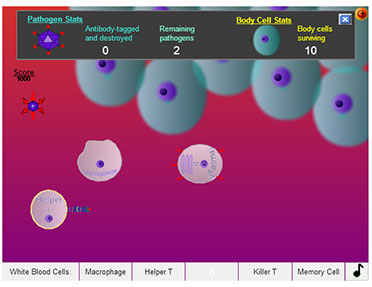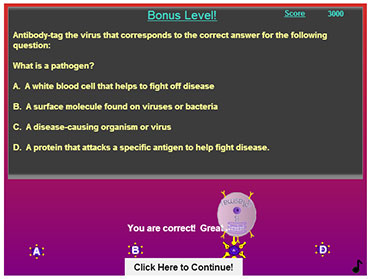Conflict: Immunity

Conflict: Immunity is a free to play browser game by Brett Baughman, a biology teacher who makes games and quizzes for his website BioMan Biology.
What does it teach?
It demonstrates a simplified model of how B cells, T cells and macrophages work together in humoral immunity and cell mediated immunity.
What do you do?
You are patrolling a single screen in top down 2D with ten nonspecific cells which you have to protect from invading pathogens. At your disposal are five different types of leukocytes (white blood cells):
- Macrophages
- Helper T cells
- B cells (Naïve B cells)
- Activated B cells (Plasma cells)
- Killer T cells (Cytotoxic T cells)
When the game starts you are given a short tutorial on the functions of each member of your leukocyte army. You then get to play the levels where you fight infections of increasing complexities. Between each level you have to answer multiple choice questions that review the material you learned in the tutorial (and which hopefully was reinforced during play). For example: “What is an antigen?” (Correct answer: “A surface molecule on a pathogen that allows the immune system to recognize the pathogen.”).
There are also some bonus levels where you just go wild, shooting antibodies on a screen swarming with pathogens. These are the low points of the game and add neither educational value nor entertainment value, just padding.
A typical core loop of play in the levels proper looks like this:
- Choose the macrophage, move it quickly to catch and eat a pathogen.
- Select the helper T cell and move it to the macrophage so that it can present its antigen to the helper T cell. Do this before another pathogen invades one of your nonspecific cells.
- Select the B cell and move it to the helper T cell. The B cell will be transformed into a Plasma Cell that can shoot antibodies.
- Select the plasma cell. Hunt for new pathogens and shoot antibodies at them.
- Select the macrophage and move in to eat the pathogens that are tagged with antibodies.
If any of your nonspecific cells have been invaded the first two steps are exactly the same but the concluding steps won’t involve B cells:
- Select a killer T cell. Move it to the helper T cell. This will activate the killer T cell.
- Move the killer T cell to one of your infected nonspecific cell. Shoot perforin and cytotoxins at the cell and it will eventually burst, killing the cell as well as the pathogen. If you’re not fast enough the pathogen will kill the cell and move on to one of the remaining cells.
This might be the abridged version (with some artistic license to boot) of the adaptive immune system, but it is still complicated enough to be pretty confusing. It will almost certainly take a while for most people to get the hang of it. Sure, in the first level you can do with just plasma cells and in the second level you only have to use killer T cells, but in later levels you have to use both and this is the hard and strategic part: to decide your priorities and get your leukocytes to work in concert against the invaders.
It is almost always a good idea to first use plasma cells as the antibody-tagged pathogens are unable to invade your cells. When just one cell is invaded the game has a way of quickly descending into chaos. On the other hand, this is where the game gets interesting, as you have to improvise your strategies as the environment changes.
Sometimes you are attacked by viruses and bacteria simultaneously and in later levels you also have antibiotics at your disposal. They don’t affect resistant bacteria, however, and this is meant to teach you about the dangers of antibiotics overuse. It’s an idea that could make for an interesting game mechanic if developed further, but in truth it doesn’t make a noticeable difference to the game play when it appears all too briefly.

The game plays much like a regular, if crude, top down shooter. Unfortunately there are some control issues: you maneuver your chosen leukocyte with one hand on the arrow keys and the other hand on the spacebar, but when you wish to select another leukocyte you have to move one hand and grab the mouse. This is really cumbersome in the heat of battle when you have to think on your feet and move quickly. Arguably, this further stresses the need to learn the different functions of the leukocytes by heart, but it could have been solved with a smarter design. It is especially annoying in the final levels when HIV appears, multiplies, and kills every leukocyte it touches while you frantically try to switch between them. A pity as that, too, is an idea with potential. If handled with just a little more care and taken a little bit further it would have made for much richer game play.
Do you learn anything?
Simulations, games that model systems with interconnecting objects and processes, are in my opinion probably the only kind of educational games where the game mechanics themselves truly have the potential to support better understanding than traditional teaching. But simulations are by no means suited for all kind of subjects. Typically they aren’t very efficient either. If you need to learn something specific in a short time, a simulation will rarely be the go-to solution. A small, focused game where the mechanics support learning by simply providing feedback and motivation, will always be a better choice if you just need to learn for example the Greek alphabet or the 20 amino acids.
Simulations can make for deep and fun game play, however, and the immune system is the kind of intricate system that just begs to be simulated. It is also a natural fit for many traditional gaming genres thanks to the war metaphors that are so easy to apply to the subject.
Though small, very rough and amateurish, Conflict: Immunity manages to give you some feel for the immune system by providing a tiny toy simulation as well as traditional action gameplay. I consider that a success by the standards of educational games with 100 times the budget.
There is certainly room for enormous improvements in presentation and interface design but my main reservations concern the role of macrophages. You almost always finish a level by eating the last pathogen with a macrophage (step 5 in the core loop). But to be able to do that you must first use the macrophage as an antigen presenting cells by eating a pathogen and presenting its antigen to a helper T cell (step 1 and 2 in the core loop).
If you don’t have any prior knowledge of the immune system this ought to strike you as strange and unnecessary. Why go through all these steps? Why not just use the macrophage alone to gobble up all the pathogens? They disappear from the screen all the same! The downside is that new ones keep appearing if you play this way. Only the antibody-tagged pathogens count when you try to rack up the required tally that the level demands, but you’re never told why. It seems arbitrary – illogical. The rules of the simulations simply fail to communicate the use of antibodies.
Pros
The basic premise of the game is sound and it is actually quite fun for a short while. It is oddly satisfying to shoot and eat the pathogens and there is a good chance that you will learn at least something. With some more work on the game design and the interface this could have been brilliant.
Cons
Difficult controls, lack of polish, minor bugs, inconsistencies and a misleading stats display are the main offenders. Better graphics and properly looping music would have been nice, of course, but not essential.
Additional information
An interview with the developer.
Ola Hansson, 28 September 2014

